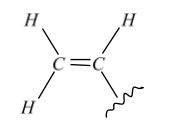
Which of the subsequent polymers doesn't have vinylic monomer units?
(A) Acrilan
(B) Nylon
(C) Polystyrene
(D) Neoprene
Answer
218.1k+ views
Hint: Polymers are materials product of long, repeating chains of molecules. The materials have unique properties, betting on the kind of molecules that are bonded and the way bonded they're. It is done due to their broad spectrum of properties, both synthetic and natural polymers play essential and ubiquitous roles.
Complete step by step answer:
Vinyl polymers are polymers made of vinyl monomers; that's, small molecules containing carbon-carbon double bonds. They create the largest family of polymers. Let's examine how we get from a vinyl monomer to a polyvinyl resin using for example the best vinyl resin, polyethylene. Polyethylene is formed from the monomer ethylene, which is additionally called ethene. When polymerized, the ethylene molecules are joined along the axes of their double bonds to create a protracted chain of many thousands of carbon atoms containing only single bonds between atoms.
Now let us see Vinylic monomer, they’re basically a monomer containing a carbon-carbon covalent bond in them.

Acrilan
${{\left( -C{{H}_{2}}=CHCN- \right)}_{n}}$
Polystyrene
${{\left( -{{C}_{6}}{{H}_{5}}-C{{H}_{2}}=C{{H}_{2}}- \right)}_{n}}$
Neoprene
${{\left( -C{{H}_{2}}=CHCl- \right)}_{n}}$
Nylon
$\begin{array}{*{35}{l}}
~{{\left( Hexamethylene\,diamine+adipicacid \right)}_{n}} \\
\end{array}$
Only nylon does not have vinylic monomer units.
So, the correct option is (B).
Note:
Vinyl polymers are made up of monomers within which one or more of the hydrogen atoms of ethylene has been replaced by another atom or groups of atoms. Not many monomers during which hydrogen atoms have been replaced on both carbon atoms will polymerize.
Complete step by step answer:
Vinyl polymers are polymers made of vinyl monomers; that's, small molecules containing carbon-carbon double bonds. They create the largest family of polymers. Let's examine how we get from a vinyl monomer to a polyvinyl resin using for example the best vinyl resin, polyethylene. Polyethylene is formed from the monomer ethylene, which is additionally called ethene. When polymerized, the ethylene molecules are joined along the axes of their double bonds to create a protracted chain of many thousands of carbon atoms containing only single bonds between atoms.
Now let us see Vinylic monomer, they’re basically a monomer containing a carbon-carbon covalent bond in them.

Acrilan
${{\left( -C{{H}_{2}}=CHCN- \right)}_{n}}$
Polystyrene
${{\left( -{{C}_{6}}{{H}_{5}}-C{{H}_{2}}=C{{H}_{2}}- \right)}_{n}}$
Neoprene
${{\left( -C{{H}_{2}}=CHCl- \right)}_{n}}$
Nylon
$\begin{array}{*{35}{l}}
~{{\left( Hexamethylene\,diamine+adipicacid \right)}_{n}} \\
\end{array}$
Only nylon does not have vinylic monomer units.
So, the correct option is (B).
Note:
Vinyl polymers are made up of monomers within which one or more of the hydrogen atoms of ethylene has been replaced by another atom or groups of atoms. Not many monomers during which hydrogen atoms have been replaced on both carbon atoms will polymerize.
Recently Updated Pages
Class 12 Chemistry Mock Test Series for JEE Main – Free Online Practice

Difference Between Alcohol and Phenol: Structure, Tests & Uses

Classification of Drugs in Chemistry: Types, Examples & Exam Guide

Chemical Properties of Hydrogen - Important Concepts for JEE Exam Preparation

JEE General Topics in Chemistry Important Concepts and Tips

JEE Atomic Structure and Chemical Bonding important Concepts and Tips

Trending doubts
JEE Main 2026: Application Form Open, Exam Dates, Syllabus, Eligibility & Question Papers

Derivation of Equation of Trajectory Explained for Students

Hybridisation in Chemistry – Concept, Types & Applications

Understanding the Angle of Deviation in a Prism

Understanding Collisions: Types and Examples for Students

Understanding Atomic Structure for Beginners

Other Pages
NCERT Solutions For Class 12 Chemistry Chapter 1 Solutions - 2025-26

NCERT Solutions for Class 12 Chemistry Chapter Chapter 7 Alcohol Phenol and Ether

NCERT Solutions ForClass 12 Chemistry Chapter Chapter 8 Aldehydes Ketones And Carboxylic Acids

JEE Advanced Marks vs Ranks 2025: Understanding Category-wise Qualifying Marks and Previous Year Cut-offs

Haloalkanes and Haloarenes Class 12 Chemistry Chapter 6 CBSE Notes - 2025-26

Solutions Class 12 Chemistry Chapter 1 CBSE Notes - 2025-26




